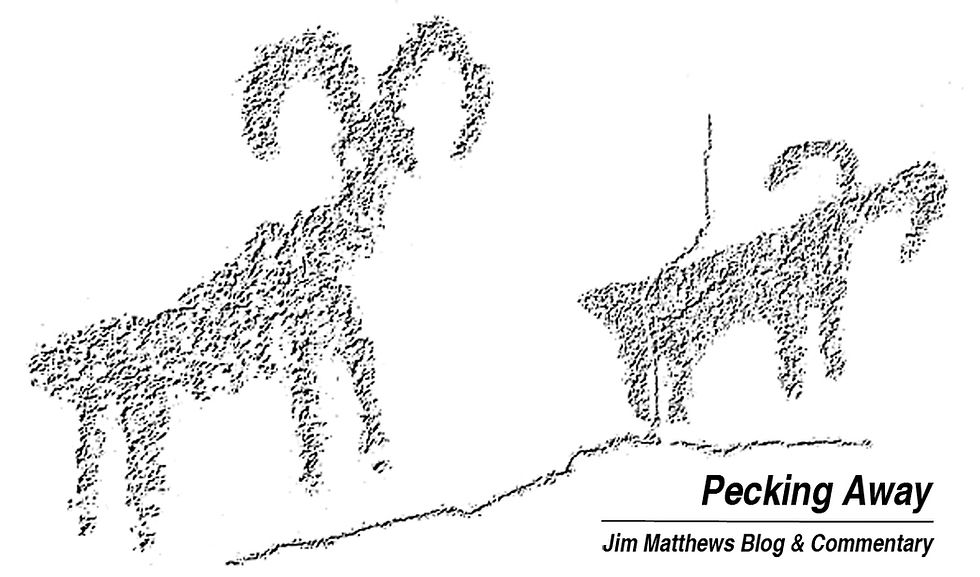New Feinstein bill would close 67 square miles to hunting in California
- Jim Matthews
- Jan 8, 2017
- 3 min read

By JIM MATTHEWS
www.OutdoorNewsService.com
Senator Dianne Feinstein introduced the California Desert Protection and Recreation Act of 2017 on Thursday this week. Among the highlights as it relates to sportsmen, the bill would ban hunting on 43,000 acres (67 square miles) by adding the property to Death Valley and Joshua Tree national parks, where hunting and other off-road recreational activities are not allowed.
The bill, called the “Environmentalist’s Shopping Cart” by opponents, has dozens of other mandates and designations that would negatively impact hunters and other recreational users, especially off-roaders.
Other aspects of the bill include:
-- Designating another 230,000 acres of federal land in Southern California as wilderness, including a number of popular off-road use areas;
-- Establishing a 75,500-acre Vinagre Wash Special Management in Imperial County, likely ending off-road vehicle travel and other uses;
-- Designating the Alabama Hills area in Inyo County as a National Scenic Area.
Many say the bill has little likelihood of passing in the new Congress.
MEXICO PLANING POPULAR FISHING SPOTS OFF-LIMITS: The creation of eight biosphere reserves off of Baja California by the Mexican fisheries department in early December has sport anglers concerned about the impacts on anglers fishing from San Diego sportfishing boats on everything from three-quarter day to extended multi-day trips.
The eight reserve areas ban commercial boats over 10 1/2-meters long from fishing in the reserves, primarily as a protection against non-Mexican seiners and shrimp trawlers, according to Western Outdoor News. That ban could include commercial sportfishing boats out of San Diego, but meetings this month on regional regulations in the new reserves may exclude sportfishing boats from the commercial ban.
Mexico’s new Natural Protected Area includes 21 islands, 97 islets, and surrounding ocean waters in eight areas, including the Coronado Islands, San Martin Island, Todos Santos Island, Cedros Island, Benitos Island, all of Magdalena Bay, and Alijos Rocks -- all popular fishing areas for sportfishing boats out of San Diego. The reserve is designed to protect wildlife and fisheries while still allowing for local use of the areas.
HUNTERS NEED TO RETURN DEER TAGS: Deer hunters have only until the end of this month to submit their deer tag harvest report information. This may be done on-line or by mailing in the report portion of their deer tag to CDFW Wildlife Branch, P.O. Box 944209, Sacramento, CA 94299-0002. The on-line reporting done at this direct link: https://www.ca.wildlifelicense.com/InternetSales/.
This requirement includes all deer hunters, not just those who were successful (as in the past). This is the second year of mandatory reporting, and hunters who do not report will be assessed a $21.60 non-reporting fee when they apply to purchase a deer tag for 2017 seasons this fall. The non-reporting fee is in addition to the cost of the deer tag.
The mandatory reporting effort will DFW biologists better data to estimate deer harvest data, determine population size, and set hunting seasons.
CIBOLA NATIONAL WILDLIFE REFUGE REVISING HUNT PLAN: Staff at the Cibola National Wildlife Refuge will be reviewing and updating it hunting plan and has asked hunters for input to help with the regulations. It is critical that hunters follow the process and comment to be sure there is no reduction in hunting activity at the refuge.
The current hunting regulations are available on the Cibola website (https://www.fws.gov/refuge/cibola/), and hunters are encouraged to comment during this scoping process with their concerns and suggestions.
Comments may be submitted in written form by mail sent to Cibola National Wildlife Refuge, Attn: Hunt Plan, 66600 Cibola Lake Rd, Cibola, AZ 85328. Or comments may be emailed to Cibola_Comments@fws.gov. All comments must be received by January 28.
PINTAIL LIMIT WILL DROP TO ONE BIRD: For the 2017-18 waterfowl hunting season, the U.S. Fish and Wildlife Service has announced the pintail limit will drop back down to a single bird after pintail numbers dropped 14 percent this past spring and 34 percent of its long-term average. Pintails remain one of the few waterfowl species that has not increased in recent years when overall duck numbers have been at record levels each of the past three years.
END
[Jim Matthews is a syndicated Southern California-based outdoor reporter and columnist. He can be reached via e-mail at odwriter@verizon.net or by phone at 909-887-3444.]























Comments